Pressure Ulcer Prevention Strategies
VerifiedAdded on 2020/06/06
|6
|1683
|406
AI Summary
This assignment delves into the topic of pressure ulcer prevention, analyzing various factors contributing to their development and exploring evidence-based strategies for mitigation. It examines risk assessment tools like the Braden scale, the role of nutrition in wound healing, and nonpharmacological interventions such as proper positioning and skin care techniques. The document synthesizes findings from multiple systematic reviews and clinical practice guidelines to provide a comprehensive understanding of pressure ulcer prevention.
Contribute Materials
Your contribution can guide someone’s learning journey. Share your
documents today.
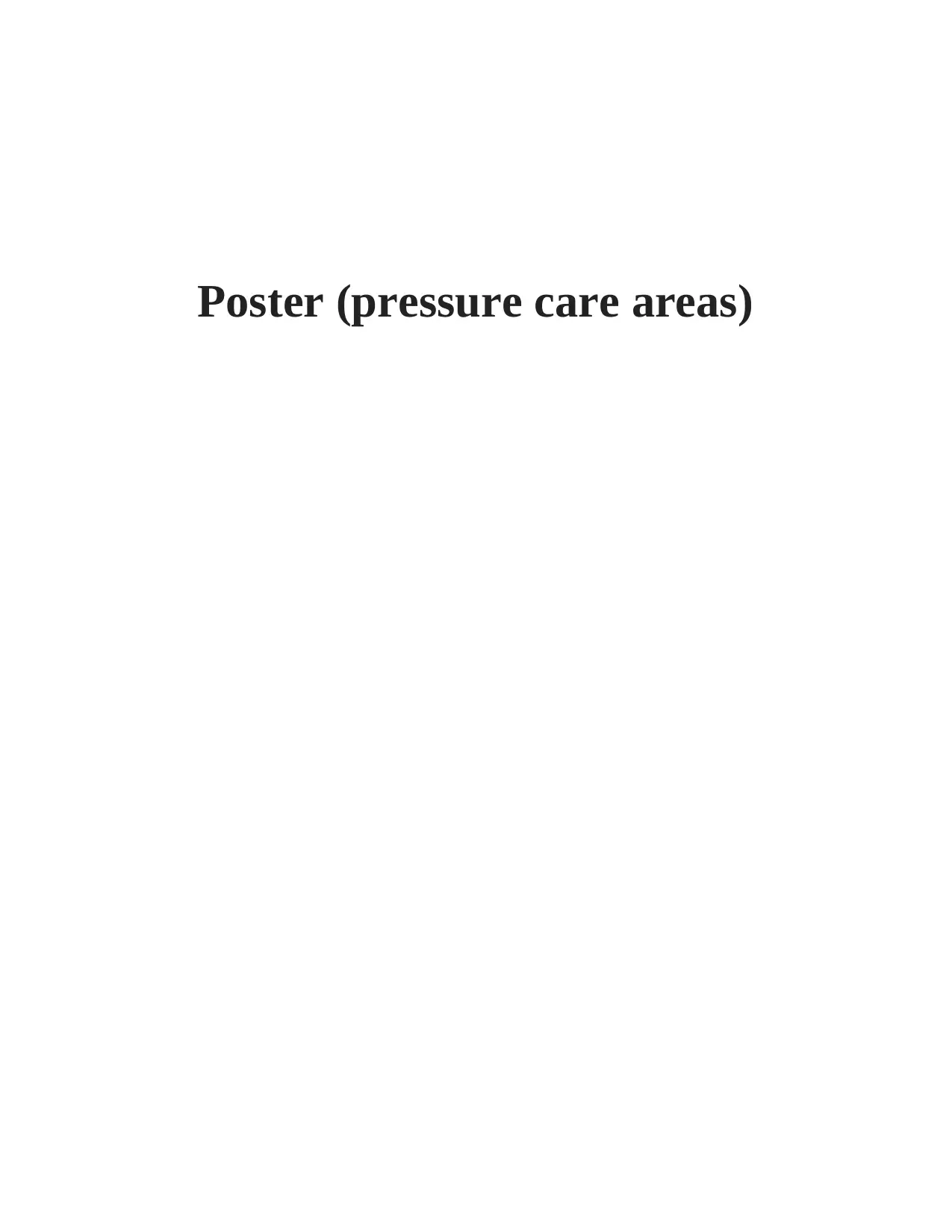
Poster (pressure care areas)
Secure Best Marks with AI Grader
Need help grading? Try our AI Grader for instant feedback on your assignments.
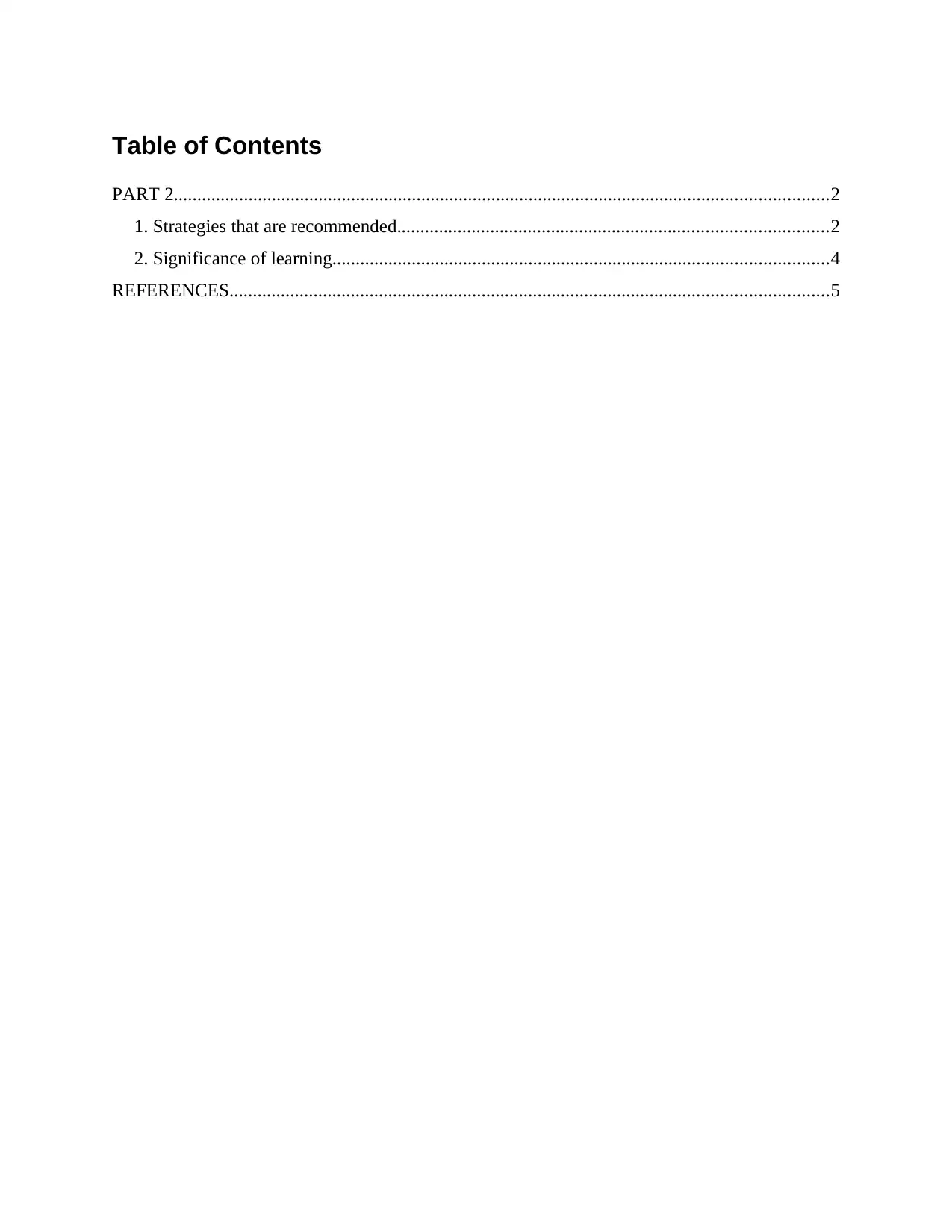
Table of Contents
PART 2............................................................................................................................................2
1. Strategies that are recommended............................................................................................2
2. Significance of learning..........................................................................................................4
REFERENCES................................................................................................................................5
PART 2............................................................................................................................................2
1. Strategies that are recommended............................................................................................2
2. Significance of learning..........................................................................................................4
REFERENCES................................................................................................................................5
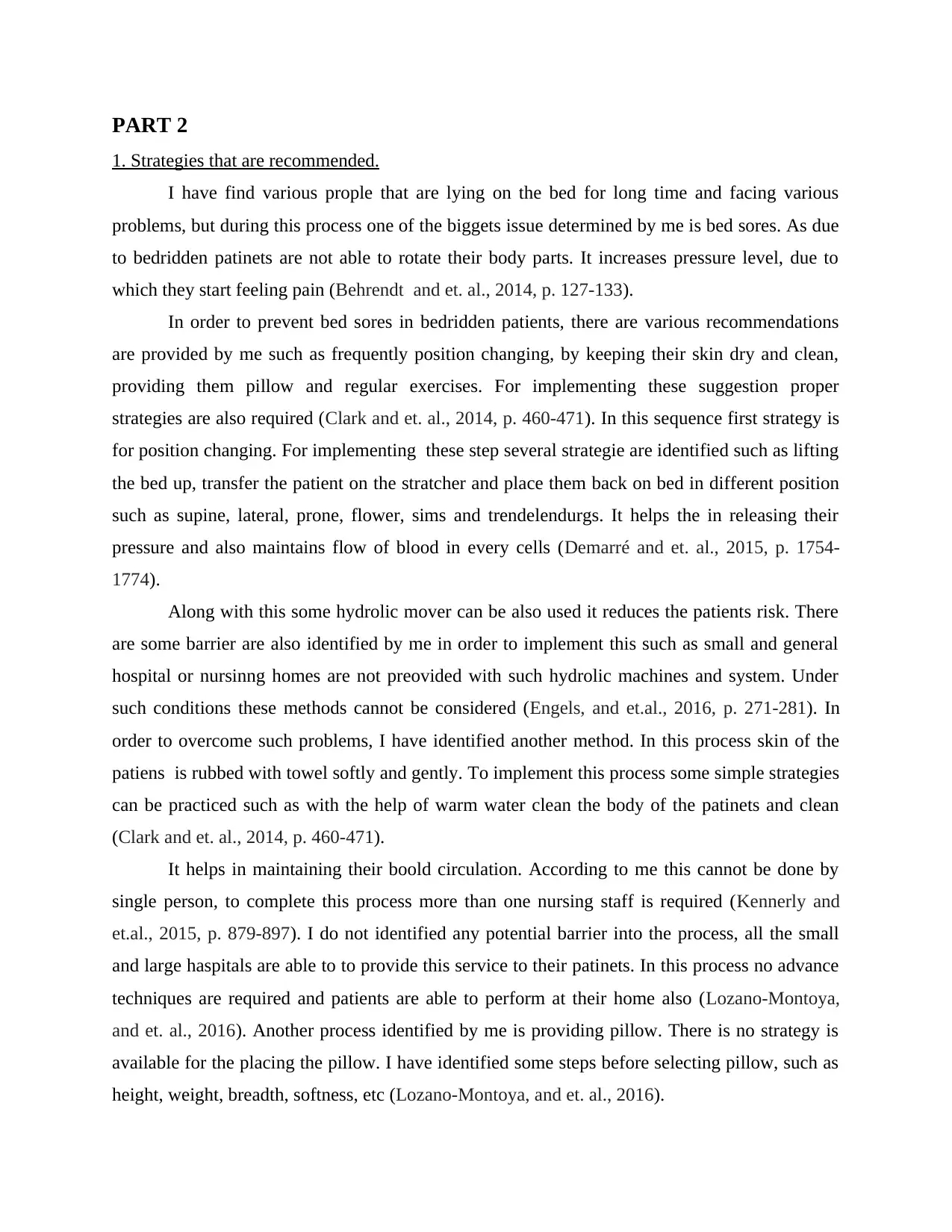
PART 2
1. Strategies that are recommended.
I have find various prople that are lying on the bed for long time and facing various
problems, but during this process one of the biggets issue determined by me is bed sores. As due
to bedridden patinets are not able to rotate their body parts. It increases pressure level, due to
which they start feeling pain (Behrendt and et. al., 2014, p. 127-133).
In order to prevent bed sores in bedridden patients, there are various recommendations
are provided by me such as frequently position changing, by keeping their skin dry and clean,
providing them pillow and regular exercises. For implementing these suggestion proper
strategies are also required (Clark and et. al., 2014, p. 460-471). In this sequence first strategy is
for position changing. For implementing these step several strategie are identified such as lifting
the bed up, transfer the patient on the stratcher and place them back on bed in different position
such as supine, lateral, prone, flower, sims and trendelendurgs. It helps the in releasing their
pressure and also maintains flow of blood in every cells (Demarré and et. al., 2015, p. 1754-
1774).
Along with this some hydrolic mover can be also used it reduces the patients risk. There
are some barrier are also identified by me in order to implement this such as small and general
hospital or nursinng homes are not preovided with such hydrolic machines and system. Under
such conditions these methods cannot be considered (Engels, and et.al., 2016, p. 271-281). In
order to overcome such problems, I have identified another method. In this process skin of the
patiens is rubbed with towel softly and gently. To implement this process some simple strategies
can be practiced such as with the help of warm water clean the body of the patinets and clean
(Clark and et. al., 2014, p. 460-471).
It helps in maintaining their boold circulation. According to me this cannot be done by
single person, to complete this process more than one nursing staff is required (Kennerly and
et.al., 2015, p. 879-897). I do not identified any potential barrier into the process, all the small
and large haspitals are able to to provide this service to their patinets. In this process no advance
techniques are required and patients are able to perform at their home also (Lozano-Montoya,
and et. al., 2016). Another process identified by me is providing pillow. There is no strategy is
available for the placing the pillow. I have identified some steps before selecting pillow, such as
height, weight, breadth, softness, etc (Lozano-Montoya, and et. al., 2016).
1. Strategies that are recommended.
I have find various prople that are lying on the bed for long time and facing various
problems, but during this process one of the biggets issue determined by me is bed sores. As due
to bedridden patinets are not able to rotate their body parts. It increases pressure level, due to
which they start feeling pain (Behrendt and et. al., 2014, p. 127-133).
In order to prevent bed sores in bedridden patients, there are various recommendations
are provided by me such as frequently position changing, by keeping their skin dry and clean,
providing them pillow and regular exercises. For implementing these suggestion proper
strategies are also required (Clark and et. al., 2014, p. 460-471). In this sequence first strategy is
for position changing. For implementing these step several strategie are identified such as lifting
the bed up, transfer the patient on the stratcher and place them back on bed in different position
such as supine, lateral, prone, flower, sims and trendelendurgs. It helps the in releasing their
pressure and also maintains flow of blood in every cells (Demarré and et. al., 2015, p. 1754-
1774).
Along with this some hydrolic mover can be also used it reduces the patients risk. There
are some barrier are also identified by me in order to implement this such as small and general
hospital or nursinng homes are not preovided with such hydrolic machines and system. Under
such conditions these methods cannot be considered (Engels, and et.al., 2016, p. 271-281). In
order to overcome such problems, I have identified another method. In this process skin of the
patiens is rubbed with towel softly and gently. To implement this process some simple strategies
can be practiced such as with the help of warm water clean the body of the patinets and clean
(Clark and et. al., 2014, p. 460-471).
It helps in maintaining their boold circulation. According to me this cannot be done by
single person, to complete this process more than one nursing staff is required (Kennerly and
et.al., 2015, p. 879-897). I do not identified any potential barrier into the process, all the small
and large haspitals are able to to provide this service to their patinets. In this process no advance
techniques are required and patients are able to perform at their home also (Lozano-Montoya,
and et. al., 2016). Another process identified by me is providing pillow. There is no strategy is
available for the placing the pillow. I have identified some steps before selecting pillow, such as
height, weight, breadth, softness, etc (Lozano-Montoya, and et. al., 2016).
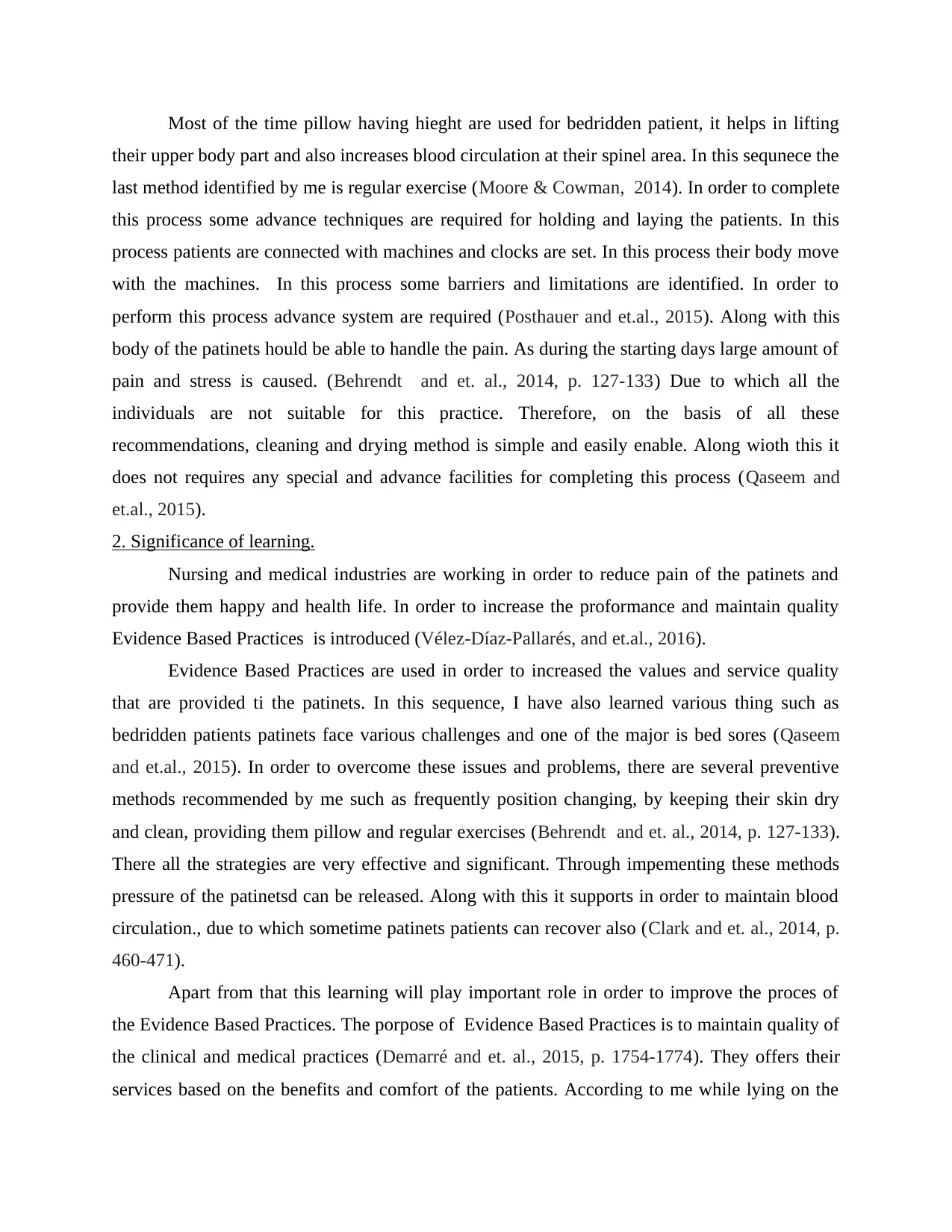
Most of the time pillow having hieght are used for bedridden patient, it helps in lifting
their upper body part and also increases blood circulation at their spinel area. In this sequnece the
last method identified by me is regular exercise (Moore & Cowman, 2014). In order to complete
this process some advance techniques are required for holding and laying the patients. In this
process patients are connected with machines and clocks are set. In this process their body move
with the machines. In this process some barriers and limitations are identified. In order to
perform this process advance system are required (Posthauer and et.al., 2015). Along with this
body of the patinets hould be able to handle the pain. As during the starting days large amount of
pain and stress is caused. (Behrendt and et. al., 2014, p. 127-133) Due to which all the
individuals are not suitable for this practice. Therefore, on the basis of all these
recommendations, cleaning and drying method is simple and easily enable. Along wioth this it
does not requires any special and advance facilities for completing this process (Qaseem and
et.al., 2015).
2. Significance of learning.
Nursing and medical industries are working in order to reduce pain of the patinets and
provide them happy and health life. In order to increase the proformance and maintain quality
Evidence Based Practices is introduced (Vélez-Díaz-Pallarés, and et.al., 2016).
Evidence Based Practices are used in order to increased the values and service quality
that are provided ti the patinets. In this sequence, I have also learned various thing such as
bedridden patients patinets face various challenges and one of the major is bed sores (Qaseem
and et.al., 2015). In order to overcome these issues and problems, there are several preventive
methods recommended by me such as frequently position changing, by keeping their skin dry
and clean, providing them pillow and regular exercises (Behrendt and et. al., 2014, p. 127-133).
There all the strategies are very effective and significant. Through impementing these methods
pressure of the patinetsd can be released. Along with this it supports in order to maintain blood
circulation., due to which sometime patinets patients can recover also (Clark and et. al., 2014, p.
460-471).
Apart from that this learning will play important role in order to improve the proces of
the Evidence Based Practices. The porpose of Evidence Based Practices is to maintain quality of
the clinical and medical practices (Demarré and et. al., 2015, p. 1754-1774). They offers their
services based on the benefits and comfort of the patients. According to me while lying on the
their upper body part and also increases blood circulation at their spinel area. In this sequnece the
last method identified by me is regular exercise (Moore & Cowman, 2014). In order to complete
this process some advance techniques are required for holding and laying the patients. In this
process patients are connected with machines and clocks are set. In this process their body move
with the machines. In this process some barriers and limitations are identified. In order to
perform this process advance system are required (Posthauer and et.al., 2015). Along with this
body of the patinets hould be able to handle the pain. As during the starting days large amount of
pain and stress is caused. (Behrendt and et. al., 2014, p. 127-133) Due to which all the
individuals are not suitable for this practice. Therefore, on the basis of all these
recommendations, cleaning and drying method is simple and easily enable. Along wioth this it
does not requires any special and advance facilities for completing this process (Qaseem and
et.al., 2015).
2. Significance of learning.
Nursing and medical industries are working in order to reduce pain of the patinets and
provide them happy and health life. In order to increase the proformance and maintain quality
Evidence Based Practices is introduced (Vélez-Díaz-Pallarés, and et.al., 2016).
Evidence Based Practices are used in order to increased the values and service quality
that are provided ti the patinets. In this sequence, I have also learned various thing such as
bedridden patients patinets face various challenges and one of the major is bed sores (Qaseem
and et.al., 2015). In order to overcome these issues and problems, there are several preventive
methods recommended by me such as frequently position changing, by keeping their skin dry
and clean, providing them pillow and regular exercises (Behrendt and et. al., 2014, p. 127-133).
There all the strategies are very effective and significant. Through impementing these methods
pressure of the patinetsd can be released. Along with this it supports in order to maintain blood
circulation., due to which sometime patinets patients can recover also (Clark and et. al., 2014, p.
460-471).
Apart from that this learning will play important role in order to improve the proces of
the Evidence Based Practices. The porpose of Evidence Based Practices is to maintain quality of
the clinical and medical practices (Demarré and et. al., 2015, p. 1754-1774). They offers their
services based on the benefits and comfort of the patients. According to me while lying on the
Secure Best Marks with AI Grader
Need help grading? Try our AI Grader for instant feedback on your assignments.
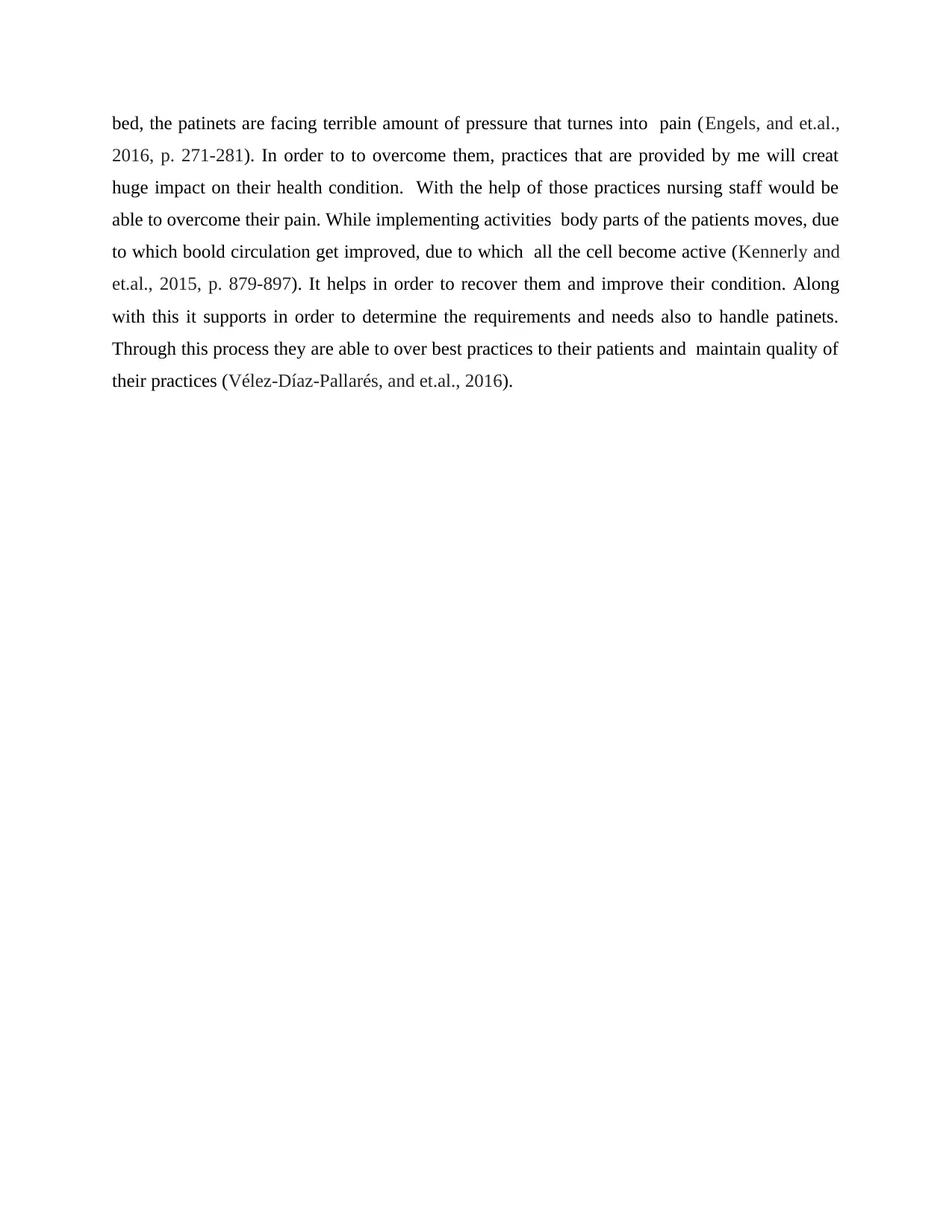
bed, the patinets are facing terrible amount of pressure that turnes into pain (Engels, and et.al.,
2016, p. 271-281). In order to to overcome them, practices that are provided by me will creat
huge impact on their health condition. With the help of those practices nursing staff would be
able to overcome their pain. While implementing activities body parts of the patients moves, due
to which boold circulation get improved, due to which all the cell become active (Kennerly and
et.al., 2015, p. 879-897). It helps in order to recover them and improve their condition. Along
with this it supports in order to determine the requirements and needs also to handle patinets.
Through this process they are able to over best practices to their patients and maintain quality of
their practices (Vélez-Díaz-Pallarés, and et.al., 2016).
2016, p. 271-281). In order to to overcome them, practices that are provided by me will creat
huge impact on their health condition. With the help of those practices nursing staff would be
able to overcome their pain. While implementing activities body parts of the patients moves, due
to which boold circulation get improved, due to which all the cell become active (Kennerly and
et.al., 2015, p. 879-897). It helps in order to recover them and improve their condition. Along
with this it supports in order to determine the requirements and needs also to handle patinets.
Through this process they are able to over best practices to their patients and maintain quality of
their practices (Vélez-Díaz-Pallarés, and et.al., 2016).
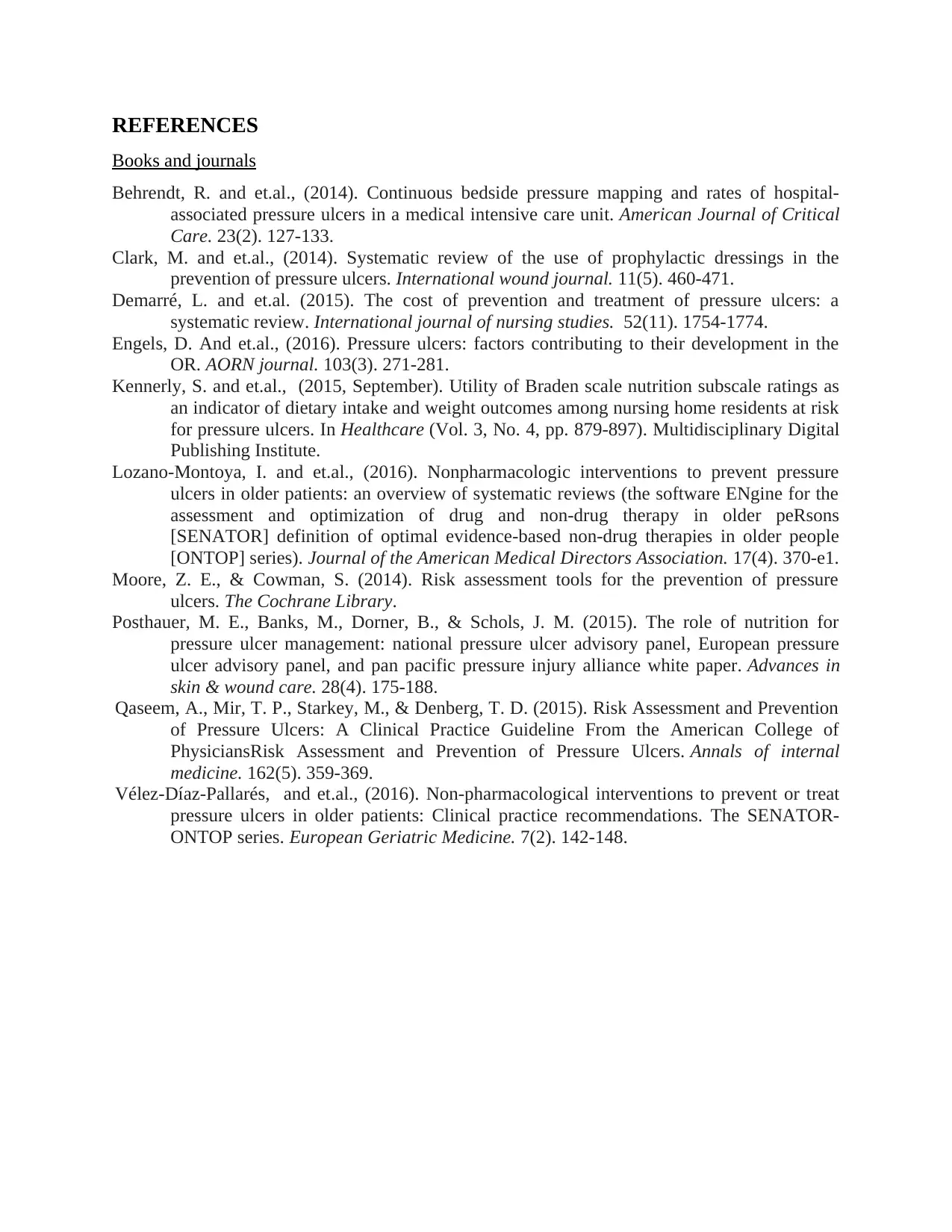
REFERENCES
Books and journals
Behrendt, R. and et.al., (2014). Continuous bedside pressure mapping and rates of hospital-
associated pressure ulcers in a medical intensive care unit. American Journal of Critical
Care. 23(2). 127-133.
Clark, M. and et.al., (2014). Systematic review of the use of prophylactic dressings in the
prevention of pressure ulcers. International wound journal. 11(5). 460-471.
Demarré, L. and et.al. (2015). The cost of prevention and treatment of pressure ulcers: a
systematic review. International journal of nursing studies. 52(11). 1754-1774.
Engels, D. And et.al., (2016). Pressure ulcers: factors contributing to their development in the
OR. AORN journal. 103(3). 271-281.
Kennerly, S. and et.al., (2015, September). Utility of Braden scale nutrition subscale ratings as
an indicator of dietary intake and weight outcomes among nursing home residents at risk
for pressure ulcers. In Healthcare (Vol. 3, No. 4, pp. 879-897). Multidisciplinary Digital
Publishing Institute.
Lozano-Montoya, I. and et.al., (2016). Nonpharmacologic interventions to prevent pressure
ulcers in older patients: an overview of systematic reviews (the software ENgine for the
assessment and optimization of drug and non-drug therapy in older peRsons
[SENATOR] definition of optimal evidence-based non-drug therapies in older people
[ONTOP] series). Journal of the American Medical Directors Association. 17(4). 370-e1.
Moore, Z. E., & Cowman, S. (2014). Risk assessment tools for the prevention of pressure
ulcers. The Cochrane Library.
Posthauer, M. E., Banks, M., Dorner, B., & Schols, J. M. (2015). The role of nutrition for
pressure ulcer management: national pressure ulcer advisory panel, European pressure
ulcer advisory panel, and pan pacific pressure injury alliance white paper. Advances in
skin & wound care. 28(4). 175-188.
Qaseem, A., Mir, T. P., Starkey, M., & Denberg, T. D. (2015). Risk Assessment and Prevention
of Pressure Ulcers: A Clinical Practice Guideline From the American College of
PhysiciansRisk Assessment and Prevention of Pressure Ulcers. Annals of internal
medicine. 162(5). 359-369.
Vélez-Díaz-Pallarés, and et.al., (2016). Non-pharmacological interventions to prevent or treat
pressure ulcers in older patients: Clinical practice recommendations. The SENATOR-
ONTOP series. European Geriatric Medicine. 7(2). 142-148.
Books and journals
Behrendt, R. and et.al., (2014). Continuous bedside pressure mapping and rates of hospital-
associated pressure ulcers in a medical intensive care unit. American Journal of Critical
Care. 23(2). 127-133.
Clark, M. and et.al., (2014). Systematic review of the use of prophylactic dressings in the
prevention of pressure ulcers. International wound journal. 11(5). 460-471.
Demarré, L. and et.al. (2015). The cost of prevention and treatment of pressure ulcers: a
systematic review. International journal of nursing studies. 52(11). 1754-1774.
Engels, D. And et.al., (2016). Pressure ulcers: factors contributing to their development in the
OR. AORN journal. 103(3). 271-281.
Kennerly, S. and et.al., (2015, September). Utility of Braden scale nutrition subscale ratings as
an indicator of dietary intake and weight outcomes among nursing home residents at risk
for pressure ulcers. In Healthcare (Vol. 3, No. 4, pp. 879-897). Multidisciplinary Digital
Publishing Institute.
Lozano-Montoya, I. and et.al., (2016). Nonpharmacologic interventions to prevent pressure
ulcers in older patients: an overview of systematic reviews (the software ENgine for the
assessment and optimization of drug and non-drug therapy in older peRsons
[SENATOR] definition of optimal evidence-based non-drug therapies in older people
[ONTOP] series). Journal of the American Medical Directors Association. 17(4). 370-e1.
Moore, Z. E., & Cowman, S. (2014). Risk assessment tools for the prevention of pressure
ulcers. The Cochrane Library.
Posthauer, M. E., Banks, M., Dorner, B., & Schols, J. M. (2015). The role of nutrition for
pressure ulcer management: national pressure ulcer advisory panel, European pressure
ulcer advisory panel, and pan pacific pressure injury alliance white paper. Advances in
skin & wound care. 28(4). 175-188.
Qaseem, A., Mir, T. P., Starkey, M., & Denberg, T. D. (2015). Risk Assessment and Prevention
of Pressure Ulcers: A Clinical Practice Guideline From the American College of
PhysiciansRisk Assessment and Prevention of Pressure Ulcers. Annals of internal
medicine. 162(5). 359-369.
Vélez-Díaz-Pallarés, and et.al., (2016). Non-pharmacological interventions to prevent or treat
pressure ulcers in older patients: Clinical practice recommendations. The SENATOR-
ONTOP series. European Geriatric Medicine. 7(2). 142-148.
1 out of 6
Your All-in-One AI-Powered Toolkit for Academic Success.
+13062052269
info@desklib.com
Available 24*7 on WhatsApp / Email
![[object Object]](/_next/static/media/star-bottom.7253800d.svg)
Unlock your academic potential
© 2024 | Zucol Services PVT LTD | All rights reserved.

